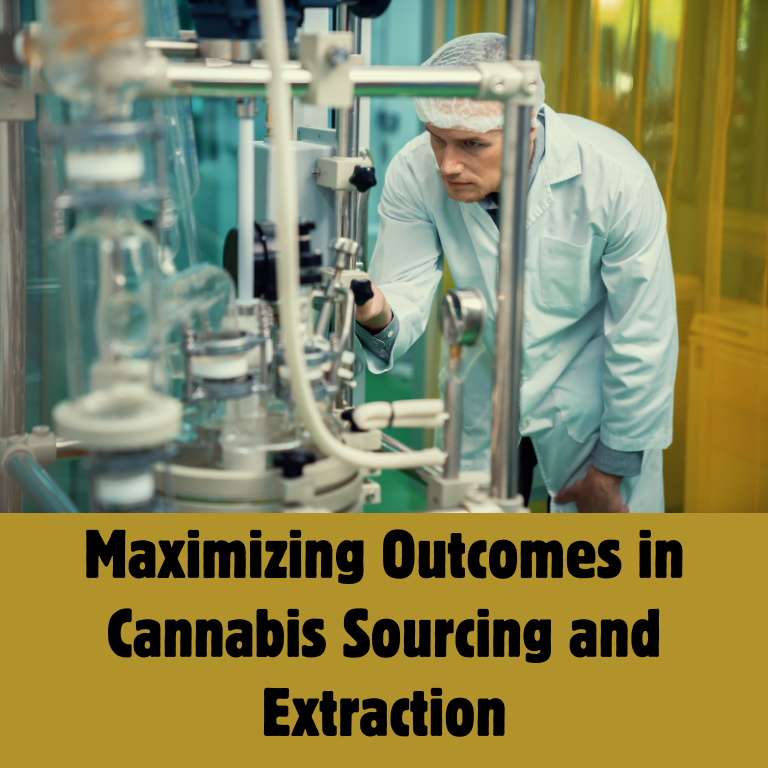Maximizing Outcomes in Cannabis Sourcing and Extraction

The cannabis industry has seen exponential growth over the past decade, with increasing demand for high-quality cannabis products driving innovation in both sourcing and extraction methods. Ensuring optimal outcomes in these processes is crucial for producing safe, effective, and consistent cannabis products. This article explores the best practices for cannabis sourcing and extraction, emphasizing the importance of quality assurance, efficient extraction methods, and strategic supplier selection.
The Importance of Quality Assurance in Cannabis Sourcing
Quality assurance (QA) is a critical component of cannabis sourcing. It involves systematic procedures to ensure that the cannabis raw materials meet predefined quality criteria, which is essential for producing high-quality end products.
Supplier Selection: Choosing the right suppliers is the first step in ensuring quality. Suppliers should be vetted for their cultivation practices, compliance with regulatory standards, and ability to provide consistent, high-quality cannabis. It’s essential to establish strong relationships with reliable suppliers who adhere to good agricultural practices (GAP).
Testing and Certification: Regular testing of cannabis raw materials is necessary to ensure they are free from contaminants such as pesticides, heavy metals, and microbial impurities. Third-party lab testing provides an additional layer of assurance, ensuring that the cannabis meets safety standards and regulatory requirements.
Traceability: Implementing traceability systems helps in tracking the cannabis from cultivation to final product. This system ensures that any issues can be quickly identified and addressed, maintaining the integrity of the product throughout the supply chain.
Efficient Extraction Methods
The extraction process is vital for obtaining cannabinoids, terpenes, and other beneficial compounds from the cannabis plant. Efficient extraction methods ensure maximum yield and potency while preserving the quality of the extracted compounds.
Solvent-Based Extraction: Solvent-based methods, such as ethanol and butane extraction, are popular due to their efficiency in extracting cannabinoids and terpenes. Ethanol extraction is particularly favored for its ability to produce high-quality, full-spectrum extracts. However, ensuring the complete removal of residual solvents is crucial to avoid contamination.
CO2 Extraction: CO2 extraction is a solvent-free method that uses carbon dioxide at high pressure and low temperature to extract compounds. This method is highly regarded for its ability to produce pure, high-quality extracts without the risk of solvent residues. CO2 extraction is also environmentally friendly, making it a preferred choice for many producers.
Rosin Press Extraction: Rosin press extraction is a solventless method that uses heat and pressure to extract cannabinoids and terpenes. This method is gaining popularity for its simplicity and the purity of the extracts it produces. It is particularly suitable for small-scale operations and artisanal producers.
Optimizing Extraction Parameters
To maximize outcomes in cannabis extraction, it is essential to optimize extraction parameters, including temperature, pressure, and time.
Temperature Control: Maintaining optimal temperatures during extraction is crucial for preserving the integrity of cannabinoids and terpenes. Excessive heat can degrade these compounds, reducing the quality of the extract.
Pressure Settings: In methods like CO2 extraction, pressure settings play a significant role in determining the efficiency and quality of the extraction. Adjusting pressure levels can help in selectively extracting specific compounds, enhancing the overall quality of the extract.
Extraction Time: The duration of the extraction process impacts the yield and potency of the extract. Shorter extraction times may result in lower yields, while longer times can lead to the extraction of undesirable compounds. Finding the right balance is key to achieving high-quality outcomes.
Post-Extraction Processing
Post-extraction processing steps are crucial for refining and purifying the extract to ensure it meets quality standards.
Winterization: This process involves the removal of fats, waxes, and lipids from the extract by dissolving it in ethanol and freezing it. Winterization helps in producing a clean, high-purity extract that is free from undesirable substances.
Distillation: Distillation is used to further purify the extract by separating cannabinoids and terpenes from other compounds based on their boiling points. This step is essential for producing highly concentrated, potent extracts.
Quality Testing: After extraction and processing, the final product should undergo rigorous testing to ensure it meets quality standards for potency, purity, and safety. This includes testing for residual solvents, pesticides, heavy metals, and microbial contaminants.
Sustainability in Cannabis Sourcing and Extraction
Sustainability is becoming increasingly important in the cannabis industry, with a growing emphasis on environmentally friendly practices.
Organic Cultivation: Sourcing cannabis from organic farms that use sustainable cultivation practices helps in reducing the environmental impact and ensures that the raw materials are free from harmful chemicals.
Energy-Efficient Extraction: Implementing energy-efficient extraction methods, such as CO2 extraction, and optimizing processes to reduce energy consumption can significantly lower the environmental footprint of cannabis production.
Waste Management: Proper waste management practices, including recycling and composting of plant materials, are essential for minimizing the environmental impact of cannabis production. Companies should also consider repurposing by-products from the extraction process to create value-added products.
Maximizing outcomes in cannabis sourcing and extraction requires a comprehensive approach that includes stringent quality assurance measures, efficient and optimized extraction methods, and a commitment to sustainability. By focusing on these key areas, producers can ensure the production of high-quality, safe, and effective cannabis products that meet consumer expectations and regulatory standards. As the industry continues to evolve, staying informed about best practices and technological advancements will be crucial for maintaining a competitive edge and ensuring long-term success.











